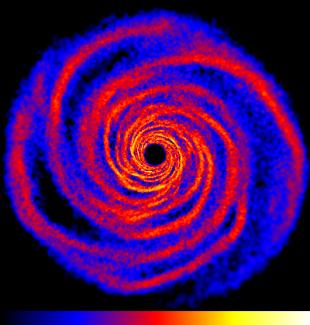Gamma-ray bursts signal the birth of a new black hole, whether it's created during the collapse of a massive star or via a merger between two compact objects such as neutron stars. Astrophysicists have determined that long gamma-ray bursts are associated with collapsing stars and short bursts are associated with binary mergers. In both cases, however, black-hole accretion powers the burst. Recently the Swift X-ray Telescope revealed another common feature: erratic X-ray flares in their afterglows. Swift has detected flare-ups in about half of the gamma-ray bursts it has observed so far.
Fellows Rosalba Perna and Phil Armitage recently hypothesized a common origin for the flare-ups: an unstable accretion disk rapidly streaming into a black hole. (A computer simulation of such an unstable disk is shown on the right.) Gravitational instabilities can easily fragment an accretion disk and lead to the formation of small-to-massive blobs of material. When the blobs spiral into the black hole, they cause an X-ray flare-up. Perna and Armitage's model is consistent with the theory that the ultimate source of power in gamma-ray bursts is the sudden torrential flow of matter into a newly formed black hole.
The researchers' analysis suggests that the formation of a fragmenting accretion disk would be more likely to occur during a massive star collapse than during a merger. The fact that Swift has only observed one short gamma-ray burst with flares appears to support this suggestion.
The work reported here, done in collaboration with Bing Zhang at the University of Nevada at Las Vegas, appeared in the January 1, 2006, issue of The Astrophysical Journal. - Julie Phillips



 The Physics Frontiers Centers (PFC) program supports university-based centers and institutes where the collective efforts of a larger group of individuals can enable transformational advances in the most promising research areas. The program is designed to foster major breakthroughs at the intellectual frontiers of physics by providing needed resources such as combinations of talents, skills, disciplines, and/or specialized infrastructure, not usually available to individual investigators or small groups, in an environment in which the collective efforts of the larger group can be shown to be seminal to promoting significant progress in the science and the education of students. PFCs also include creative, substantive activities aimed at enhancing education, broadening participation of traditionally underrepresented groups, and outreach to the scientific community and general public.
The Physics Frontiers Centers (PFC) program supports university-based centers and institutes where the collective efforts of a larger group of individuals can enable transformational advances in the most promising research areas. The program is designed to foster major breakthroughs at the intellectual frontiers of physics by providing needed resources such as combinations of talents, skills, disciplines, and/or specialized infrastructure, not usually available to individual investigators or small groups, in an environment in which the collective efforts of the larger group can be shown to be seminal to promoting significant progress in the science and the education of students. PFCs also include creative, substantive activities aimed at enhancing education, broadening participation of traditionally underrepresented groups, and outreach to the scientific community and general public.